
Colpodaspis thompsoni
Brown, 1979
Order: CEPHALASPIDEA
Superfamily: DIAPHANOIDEA
Family: Diaphanidae
DISTRIBUTION
Tropical Indo-West Pacific.
PHOTO
Kerama Is. near Okinawa, Japan. 5m depth. Length 2 to 3mm. PHOTO: Atsushi Ono.
Small, but brightly coloured, snail-like sea slug. The fragile bubble-shaped shell is completely enveloped by the mantle. On the right side of the mantle there is an elongate exhalent siphon. The head is produced into a pair of enrolled tentacles or rhinophores which lead to a deep lateral groove on each side. The eyes are embedded beneath the skin and can be seen as two black spots just in front of the shell. There is a large central mucus gland in the sole of the foot which probably produces a sticky mucus enabling the animal to stick on the algae on which it is found. It is black with large yellowish warts on white patches.
We know nothing of the biology or food of any species of Colpodaspis.
The placing of Colpodaspis with Diaphana and Newnesia in the Diaphanoidea, by most experts, is a marriage of convenience rather than a convincing statement of phylogenetic relationships. Further studies are required before we can say anything sensible about their relationship to each other and to other opisthobranchs.
Reference:
• Brown, G.H. (1979) An investigation of the anatomy of Colpodaspis pusilla (Mollusca: Opisthobranchia) and a description of a new species of Colpodaspis from Tanzanian coastal waters. Journal of Zoology, London, 187: 201-221.
Rudman, W.B., 2000 (February 3) Colpodaspis thompsoni Brown, 1979. [In] Sea Slug Forum. Australian Museum, Sydney. Available from http://www.seaslugforum.net/find/colpthom
Related messages
Re: Colpodaspis thompsoni from the Red Sea
August 19, 2008
From: Oren Lederman
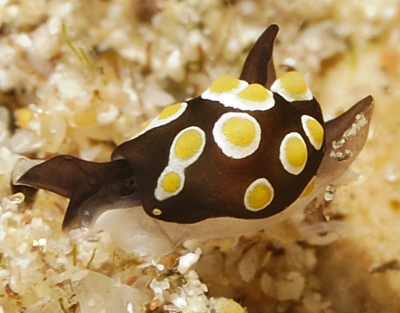
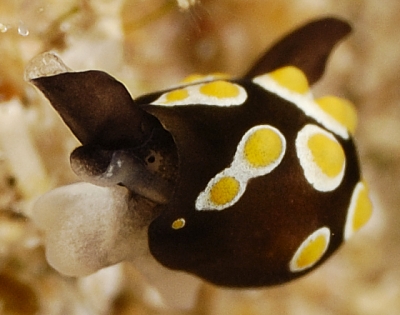
Concerning message #15060:
Hi Bill,
Here are some more photos of another Colpodaspis thompsoni I found recently.
, ~10 meters, Israel, Red Sea, 17 June 2008. Photographer: Oren Lederman.
Oren Lederman.
seaslugforum@oren.lederman.name
Lederman, O., 2008 (Aug 19) Re: Colpodaspis thompsoni from the Red Sea. [Message in] Sea Slug Forum. Australian Museum, Sydney. Available from http://www.seaslugforum.net/find/21808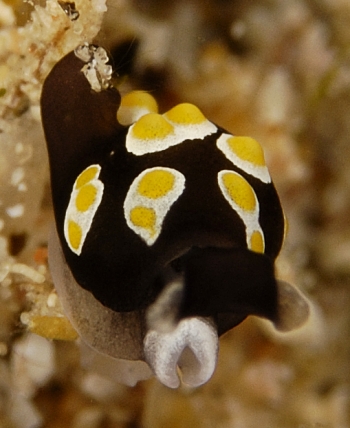
Thanks Oren,
Best wishes,
Bill Rudman
Colpodaspis thompsoni mating
July 15, 2008
From: Ayumi Murakami
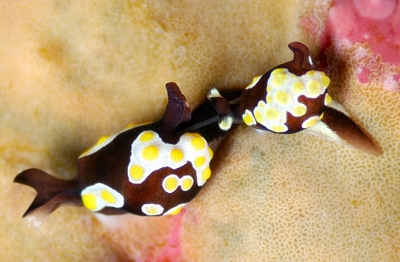
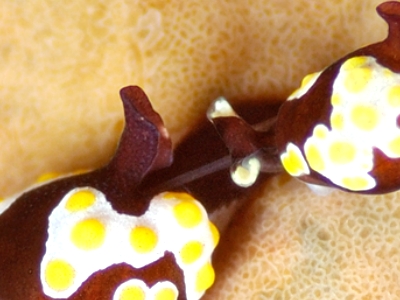
Concerning message #21033:
Dear Bill
I have observed two Colpodaspis thompsoni crawling in line. When I watched them carefully, I could see a kind of white tube running between them.
It was like both were joined by this as I took many pictures and they were connected the entire time.
Are they animals breeding or is it something else?
Locality: Kerama Island in Okinawa, 15 m, Japan, East China Sea, 8 June 2008, on rock. Length: around 2.5 mm and 3 mm. Photographer: Ayumi Murakami.
Best Regards
Ayumi Murakami
umiushi2@masea.info
Ayumi Murakami, 2008 (Jul 15) Colpodaspis thompsoni mating. [Message in] Sea Slug Forum. Australian Museum, Sydney. Available from http://www.seaslugforum.net/find/21701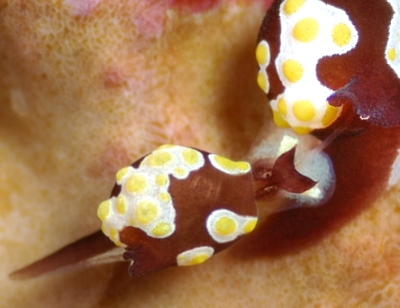
Dear Ayumi,
Thanks for this interesting observation which is a valuable addition to your earlier message [#18191] on their egg-laying. The white tube is the penis of the posterior animal. Like all sea slugs, Colpodaspis is hermaphrodite, with a full set of male and female organs. In most of the more primitive shelled opisthobranchs the penis is on the right side of the head, alongside the mouth, and when not in use it is hidden in a pocket in the body cavity. Our only knowledge of its reproductive system is Greg Brown's (1979) detailed description of a preserved specimen. Your photo is the first evidence we have of just how far the penis can extend in this species.
In your photos we can see the penis disappearing into the flap-like exhalent siphon of the anterior animal. The exhalent siphon, leads directly to the enclosed mantle cavity, and the the female genital opening. Although Colpodaspis is hermaphrodite, the arrangement of its reproductive organs means that it is probably too difficult for it to act simultaneously as both male and female during mating. This is quite different from the case in most nudibranchs, which have the male and female organs very close together. Having the two organs close together means that two partners can easily act as male and female simultaneously during mating.
-
Brown, G.H. (1979) An investigation of the anatomy of Colpodaspis pusilla (Mollusca: Opisthobranchia) and a description of a new species of Colpodaspis from Tanzanian coastal waters. Journal of Zoology, London, 187: 201-221.
Best wishes,
Bill Rudman
Nudibranch or cowrie?
November 1, 2007
From: James A. Loyola
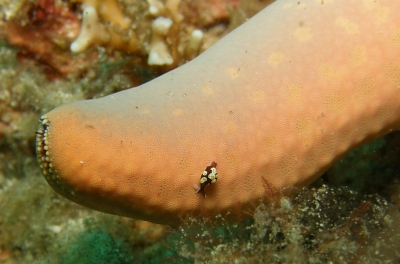
Dear Bill,
I saw this very small animal crawling relatively fast on a starfish before falling into the sand. I dont know if its a nudibranch. I hope you can help me identify it.
Locality: Arthur's Rock, Anilao, Batangas, 40 feet, Philippines, Pacific Ocean, 21 October 2007, coral rubble. Length: less than 1mm. Photographer: James A. Loyola.
Thank you
James A. Loyola
jaloyola88@yahoo.com
Loyola, J.A., 2007 (Nov 1) Nudibranch or cowrie?. [Message in] Sea Slug Forum. Australian Museum, Sydney. Available from http://www.seaslugforum.net/find/21033
Dear James,
This is Colpodaspis thompsoni. It certainly looks quite like an ovulid or a cowrie but the shape of the head and tentacles are quite different. It belongs to a primitive group of opisthobranchs which we dont know much about.
Best wishes,
Bill Rudman
Colpodaspis thompsoni from Reunion Island
August 21, 2007
From: Philibert Bidgrain
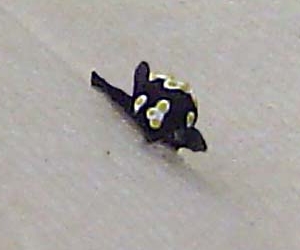
Dear Bill,
Reunion Island seaslugs
Just a message to confirm the presence of this little seaslug (about 3 mm) in the south west of Indian Ocean area.
Locality: Saint Leu, Reunion Island, Indian Ocean. Length: 3 mm. Photographer: Emmanuel Eby.
Best regards
Philibert Bidgrain
http://vieoceane.free.fr/runseaslug/indexslug.htm
pbidgrain@yahoo.fr
Bidgrain, P., 2007 (Aug 21) Colpodaspis thompsoni from Reunion Island. [Message in] Sea Slug Forum. Australian Museum, Sydney. Available from http://www.seaslugforum.net/find/20496Thanks Philibert,
We don't really need to confirm it is found in your area because the species was named from animals from Dar es Salaam, Tanzania. Greg Brown found the specimens when he was visiting me in 1976. He couldn't really believe his luck. At the time he had just discovered quite large populations of the European species Colpodaspis pusilla in England, a species which up to then had been considered extremely rare. So to come to the tropics and find a second, and unnamed, species of the same genus was quite exciting.
-
Brown, G.H. (1979) An investigation of the anatomy of Colpodaspis pusilla (Mollusca: Opisthobranchia) and a description of a new species of Colpodaspis from Tanzanian coastal waters. Journal of Zoology, London, 187: 201-221
Best wishes,
Bill Rudman
Colpodaspis thompsoni from the Solomon Ids
August 15, 2007
From: Donald Brown
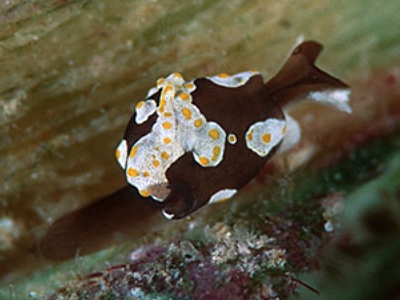
Leslie Harris from the Natural History Museum, LA, suggested I send this off to you in case it is a useful record for species distribution.
It was found on the edge of a Giant Clam shell, Tridacna sp.
Locality: Mary Island, 30 ft, Solomon Islands, Pacific, 23 April 2007, coral reef w rubble. Length: 5 mm. Photographer: Donald Brown.
Donald Brown
www.wantphoto.com.
wantphoto@gmail.com
Brown, D., 2007 (Aug 15) Colpodaspis thompsoni from the Solomon Ids. [Message in] Sea Slug Forum. Australian Museum, Sydney. Available from http://www.seaslugforum.net/find/20453Thanks Don,
Records of this little animal are always welcome.
Best wishes,
Bill Rudman
Colpodaspis thompsoni laying eggs
November 3, 2006
From: Ayumi Murakami

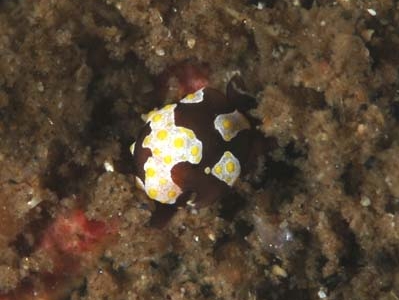
Concerning message #1838:
Dear Bill
I am sending you some wonderful pictures of a Colpodaspis thompsoni laying eggs.
Locality: Futoh, Izu Peninsula, 2m, Japan, Pacific ocean, 22 October 2006, On rock. Length: 2 mm. Photographer: Ayumi Murakami.
I started observing and taking pictures of the sea slug, when suddely it began to lay eggs. Over a short period of time it layed a large quantity of eggs.
Although, unfortunately, it did not produce a perfect shaped egg ribbon.
I hope these pictures are useful for your reseaech.
Sincerely
Ayumi Murakami
umiushi@masea.info
Ayumi, M., 2006 (Nov 3) Colpodaspis thompsoni laying eggs. [Message in] Sea Slug Forum. Australian Museum, Sydney. Available from http://www.seaslugforum.net/find/18191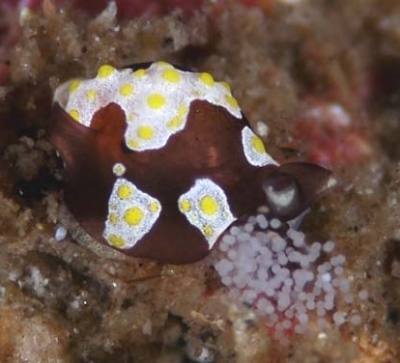
Dear Ayumi,
Thanks for these interesting photos. We know very little about the biology of species of Colpodaspis so photos like this are very valuable. It seems that this species lays quite large eggs in a mass of jelly-like mucus.
Best wishes,
Bill Rudman
Colpodaspis thompsoni in southern Queensland
July 20, 2006
From: Gary Cobb
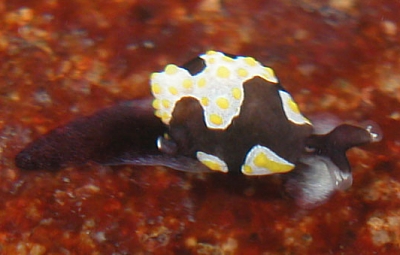
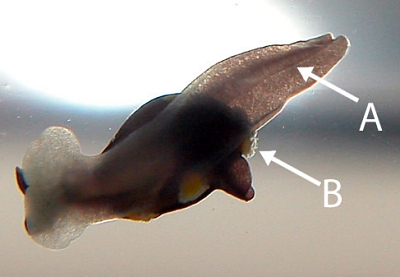
Hi Bill and everyone,
Just thought you might be interested in a new record for southern Queensland. Colpodaspis thompsoni found in 16 m of water, at a site called Hanging Rock, inner Gneerings.
Locality: Hanging Rock, inner Gneerings, Mooloolaba Sunshine Coast, 16 m, Queensland, Pacific Ocean, 20 May 2006, Subtidal. Length: 5 mm. Photographer: Gary Cobb.
In one of the photos I have inserted arrows to indicate the split tail [A] and the gills [B] . This animal is very interesting!! So small and to go diving and spot it was quite a thrill. One more thing, our new book, Undersea Jewels has gone to the ABRS and they are very excited about it, due for printing in July this year. Will keep you posted.
Cheers
Gary Cobb
gary@nudibranch.com.au
Cobb, G.C., 2006 (Jul 20) Colpodaspis thompsoni in southern Queensland. [Message in] Sea Slug Forum. Australian Museum, Sydney. Available from http://www.seaslugforum.net/find/16678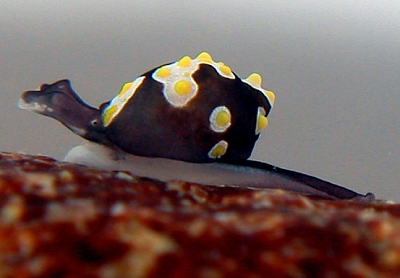
Thanks Gary,
Nice to fill in another gap in its wide distribution. The 'split tail' you mention is a groove along the sole of the foot from a large mucus gland sitting in the midline about halfway down the sole of the foot. I assume the mucus is used to form a sticky thread [or safety line] to keep the animal attached to the substrate.
Best wishes,
Bill Rudman
Colpodaspis thompsoni from the Red Sea
October 24, 2005
From: Oren Lederman
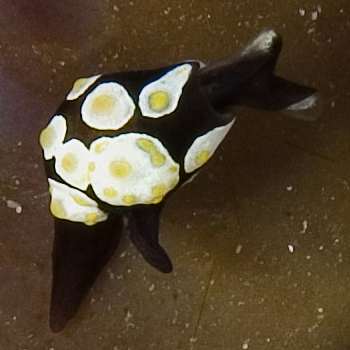
Hi Bill,
This is the second time I have seen this kind of opisthobranch (first time was on a night dive), this time with a better camera so it's possible to see the small details.
Locality: The "Princess" beach, Eilat Bay, Israel. Red Sea. Depth: ~12 meters. Length: 0.5 cm. 10 October 2005. Coral head. Photographer: Oren Lederman
Can you identify it ?
Thanks,
Oren
lederman@bigmail.co.il
Lederman, O., 2005 (Oct 24) Colpodaspis thompsoni from the Red Sea. [Message in] Sea Slug Forum. Australian Museum, Sydney. Available from http://www.seaslugforum.net/find/15060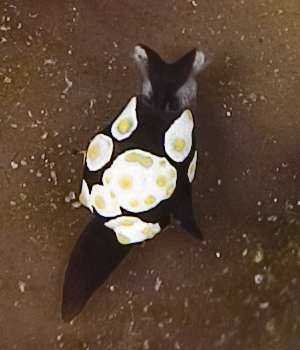
Dear Oren,
This is Colpodaspis thompsoni. It has fragile internal shell and is considered to be related to the Diaphanidae. However as we don't really know what the Diaphanidae are related to they still are a rather mysterious group. If I had money to give away, I think I would offer a prize to the person who discovers what these animals feed on.
Best wishes,
Bill Rudman
Colpodaspis thompsoni from Christmas Island
May 7, 2002
From: W.B. Rudman
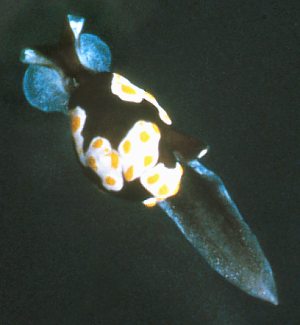
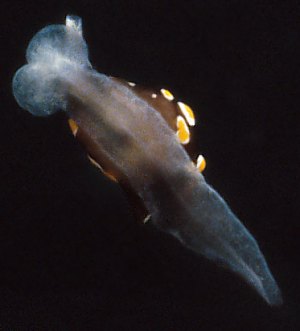
Here is some information and photos on Colpodaspis thompsoni from John Hicks' Christmas Island, Indian Ocean collections.
This specimen was 2 mm long alive.
PHOTOS: AM C127464, 10 February 1981, off boat ramp, 3m, under piece of broken coral, Christmas Is., Indian Ocean. Photo: John Hicks
Best wishes,
Bill Rudman
Colpodaspis thompsoni from NE Sulawesi
August 12, 2001
From: Jim Anderson
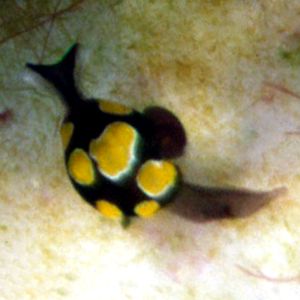
Dear Dr. Rudman,
Can you help ID the enclosed animal? I am not sure it is a nudibranch or sea slug, it was so tiny. The dive guide found it for me, no doubt testing how small an animal I would try to photograph. How he spotted it I don't know, in a 2 knot current at 26 metres across a coral rubbly sand bottom at Mary's Point, Banka Island, NE Sulawesi on 25 June 01. From the slide at 1:1 it measures 2 mm at its widest dimension.
Regards,
Jim A
jander4454@aol.com
Anderson, J., 2001 (Aug 12) Colpodaspis thompsoni from NE Sulawesi. [Message in] Sea Slug Forum. Australian Museum, Sydney. Available from http://www.seaslugforum.net/find/5007Dear Jim,
This is Colpodaspis thompsoni. I'm afraid it doesn't grow very big at all.
Best wishes,
Bill Rudman
Colpodaspis thompsoni from Kerama Id
February 4, 2000
From: Atsushi Ono

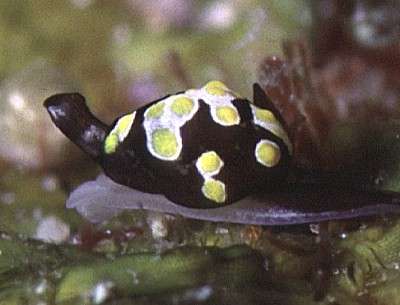
Dear Bill,
Here are some animals which I cannot decide whether they are Opisthobranchs or not.
I found this species at the reef edge and in a bay, about 5m depth. [at Kerama Is. near Okinawa in Japan].
They have eyes at a root of a siphon. They have shells, and their length is 2 to 3mm.
What is this species?
Sincerely,
Atsushi Ono
ononini@cosmos.ne.jp
Ono, A., 2000 (Feb 4) Colpodaspis thompsoni from Kerama Id. [Message in] Sea Slug Forum. Australian Museum, Sydney. Available from http://www.seaslugforum.net/find/1838Dear Atsushi,
At last I can identify an animal for you. It is Colpodaspis thompsoni which Greg Brown first discovered while he was visiting me in Tanzania in 1976. I look on this species as an 'old friend'.
Unfortunately we know nothing of its biology. It has sometimes been found in eastern Australia and I found one specimen in New Caledonia.
Best wishes,
Bill Rudman.
